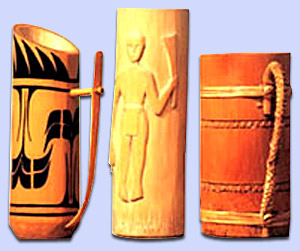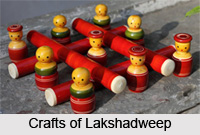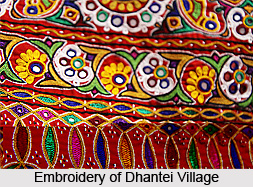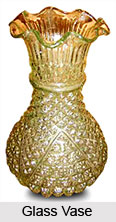 Glass has had found its creative stature as a medium to reflect imagination beyond the barriers of history, culture and time. It refracts futuristic nostalgia, the artistic contemplation of post contemporary mind. Glass craft has its ramification that spread from items of home decoration to the household items, glass bangles, to glass painting and mosaic. History of civilization paints that present generation discounts the preceding ones, thus the exuberance of glass crafts firing the sensory perception of man for time immemorial. Ancient scriptures attest the existence of glass items of the contemporary period though their abundant usage was hardly manifested.
Glass has had found its creative stature as a medium to reflect imagination beyond the barriers of history, culture and time. It refracts futuristic nostalgia, the artistic contemplation of post contemporary mind. Glass craft has its ramification that spread from items of home decoration to the household items, glass bangles, to glass painting and mosaic. History of civilization paints that present generation discounts the preceding ones, thus the exuberance of glass crafts firing the sensory perception of man for time immemorial. Ancient scriptures attest the existence of glass items of the contemporary period though their abundant usage was hardly manifested.
Origin of Glass Craft
Europe first set the stage on fire with the introduction of glass craft and during the Middle Ages the Chinese artisans mastered the craft borrowing the same from Europe. According to the historical annals, the collaboration of British East India Company and China was responsible to pioneer the art in India. During the initiation period, the dwellers of India would paint pictures related to ancient scriptures, popular stories, epic themes, icons, portraits, and icons. The art that unfurled within the colonial space of anglicized patronage bears the testimony to grand architectural exploits in the multicultural 21st century India.
History of Glass Craft in India
Glass making in India is very old. Reference of glass craft is found in the great epic of Mahabharata. The art of glassware got great impetus during the medieval period. The credit of introducing the art of glass engraving in India goes to the Mughals. The Mughal craftsmen excelled in making delicate foliated designs on glass objects. The craft was further patronised by the Rajputs for their refined sense of beauty and artistry.
Features of Glass Craft
Current western capitalist society emerged and developed in the 20th century under mass media influence. The gorgeous bangles exquisitely carved out of glass in different colours, shapes, styles and trend were hugely in demand in many places of India under the influential discourse of flimsy fashions. Inexpensive and adorable for their look, glass bangles are often studded with glass gems, spirals of base-metal wire, foil and spangles amid a wavy striping of other colours. Jewellery like necklaces that are made out of intricately cut glasses of incandescent colours deftly polished which gives the shimmer of elegance even come out from glass kitty.
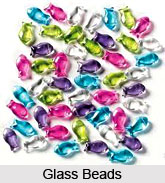 Artefacts of Glass Craft
Artefacts of Glass Craft
The domain of painting has reached a new dimension with the influx of glass painting and art of glass craft geared with a whole new facet. Glass painting as an expression of glass craft got its first exposure in India in the late eighteenth century and early nineteenth century. Glass painting excels in superior quality glass, imported from Britain and Belgium engaging in the manufacturing of showpieces of different sizes and shapes. Various decorative glass bottles of stained glass, decorative glass decanter are admired for interior decoration. Exquisitely decorated crystal flower vase, glass bottles, glass decanters are available in wide variety and comes in various tint.
Glass lamps are decently designed with eye-catching hues and designs in the recent days and stands as a logo of the artistry of glass craft available in traditional and modern outlook. They vary from hanging lamps, ceiling hanging lamps, hanging candle lamps, beaded hanging lamps, hanging lamp shades. Chandeliers are a variation of glass craft that serve the purpose of enhancing the grandeur of decor enhancing the mystery of dark nights. Variety comes in different forms like chandelier lampshades, beaded chandelier, and crystal chandelier and so on. Glass candleholder, votives, tableware and lantern as well as a large variety of Christmas decors are offered like glass ball, glass animals, Christmas decoration hanging etc for decoration.
Another kind of glass craft is the craft of ceramic, which are very popular as one of the Indian crafts. Regional differences reason the variations of ceramic craft. Though the ceramic craft requires the involvement of hand for making the items but due to the huge demand of the items, machines are involved to create things of identical quality and standard. The ceramic items are made durable by adding stone to the mould. Some ceramic items are candleholders, lamps, show pieces, sculptures and statues.
Craftmen of Glassware
The present day glass craft in India has evolved in style, utility and affordability with tiime. From the decorative items of the royals to the home utility items like lamps, bottles, window panes, crockery, etc. the use of glass craft has changed but the aura and elegance of the craft remains the same. Ferozabad, in the state of Uttar Pradesh, is well known for production of glass bangles and utilitarian glassware. There are some families having centuries old tradition of glassware manufacturing. Glass beads of India are famous world over. Varanasi is the main center for the production of glass beads while Purdilpur is famous for its black glass beads.



